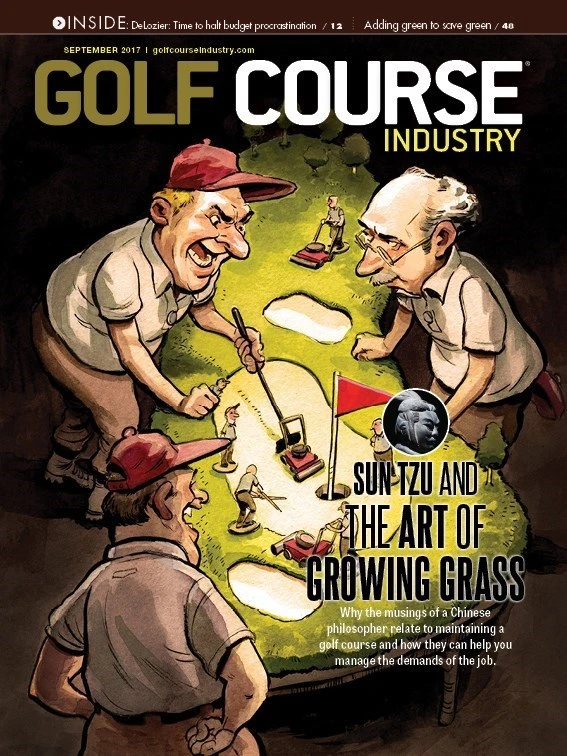Labor Day has come and gone and the 2017 season begins to wind down. We saw another decent year with experts touting what looks like a slight bump in rounds so far.
Yay, I guess.
Tracking rounds played is a fool’s errand. It’s more of an indication of temperate weather than industry health. The real metric is revenue and profitability growth. Are the cash registers ringing and are you netting more than last year?
As I look around our industry, it’s clear the market’s historic core is healthy and growing. Let me give you one piece of evidence: I routinely ask execs from turf industry supply companies if their golf market revenues are growing and every single one of them replied yes.
This despite the fact we’re closing 150-plus courses annually, millennials hate us, brick-and-mortar golf retail stores are closing and every two weeks some op/ed writer for Time or Fortune or Newsweek declares golf dead. So what gives?
The fundamental misunderstanding of outsiders looking in at us is that there isn’t just one golf market. There are five or six, and none of them have much to do with Golf Galaxy failing or Topgolf exploding. Some are doing awesome and some are not. Allow me to elucidate.
The top 1,000 private clubs are kicking ass financially. They have the reputation and resources not only to hire great superintendents and invest in their courses, but also to have top-notch sales and marketing folks driving revenues through events and activities. In today’s market, an energetic sales director is the second most important person to a club’s success behind a strong superintendent.
Conversely, the mid-scale and modestly budgeted clubs are a mixed bag depending on the competitive set in their locale and the quality and creativity of their management. Some exceed expectations and generate robust profits because they actually try new things, measure if they work and adjust accordingly. They also invest as much as feasible. Those who do the same thing year after year and hope for the best are largely screwed in the long run. They won’t be able to support the costs and expectations of a private club structure with a mediocre product in the future. “Improve or die” should be their mantra.
Facilities tied directly to real estate developments (particularly those built during the ’90s boom) are hurting. In short, these are amenity courses meant to sell homes, not golf. The limitations they face in marketing themselves, inaccessibility to non-residents, and HOA and developer restrictions make it hard to break even. Lots of these facilities end up under MCO umbrellas of some kind and are managed to control costs, not grow revenues. That is not a long-term formula for success.
Creative, well-managed daily fees are also doing well in areas that aren’t hopelessly overbuilt. I love some of the promotions I see these courses doing to attract women, younger players, leagues and outings. The smart ones have avoided some of the pitfalls of handing over a bunch of tee times to GolfNow by offering demand-based variable pricing, value-adds and (dare I say it?) FUN.
At the other end of the spectrum are mom-and-pop facilities (and some munis) that just offer cheap, crappy golf. They have commoditized themselves to death by only focusing on price, discounting instead of offering value, and largely ignoring customer service and decent conditions. Many don’t even employ a turf pro. They do no marketing. All they do is bitch about how bad the business is. They don’t buy much stuff and they don’t grow the game. They just exist to suck a little value out of the market the rest of us are building.
Government ops is another category doing fine with talented management. We’re fortunate to have an awesome golf division within our Metroparks system in Cleveland and I find them in other bigger cities and counties. Yes, many course owners think the government shouldn’t compete against private industry, but I’ve always felt it was meaningful that golf is considered to be an important form of recreation and fitness. In fact, I see munis taking the lead in places to promote the fact that playing golf is actually healthy for you. What a concept, huh?
A sense of ownership is the commonality that will win in the future. When leaders and managers take responsibility for trying new things, borrowing business practices from other segments and focusing on customer service, they will do just fine even in tomorrow’s substantially smaller and more demanding golf industry.

Explore the September 2017 Issue
Check out more from this issue and find your next story to read.
Latest from Golf Course Industry
- From the publisher’s pen: Conscientious of a bigger role
- Bernhard and Company partners with Laguna Golf Phuket
- Terre Blanche showcases environmental stewardship
- VIDEO: Introducing our December issue
- Bernhard and Company introduces Soil Scout
- Nu-Pipe donates to GCSAA Foundation’s Centennial Campaign
- GCSAA enhances golf course BMP tool
- Melrose leadership programs sending 18 to 2026 GCSAA Conference and Trade Show





